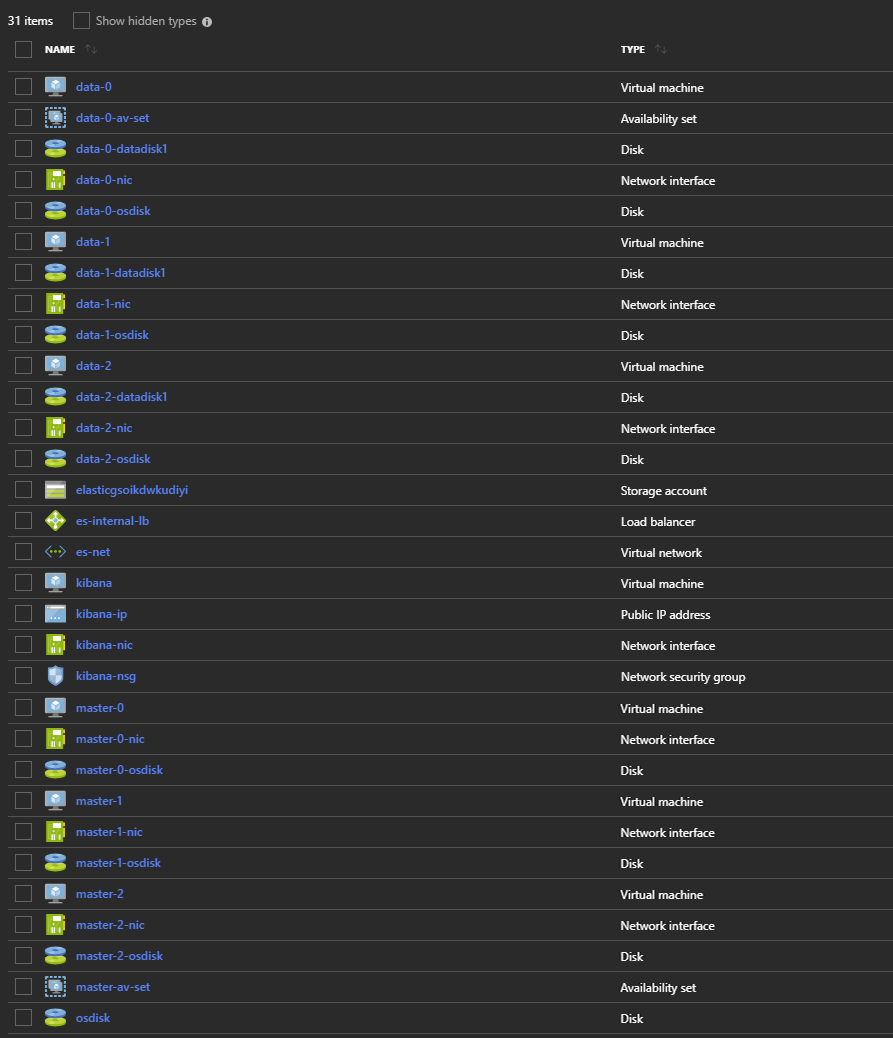Frequently Asked Questionsedit
- What resources does the Marketplace deploy?
-
The default configuration of the Marketplace deploys the following resources:
- 1 virtual network
- 3 dedicated master node Standard_DS1_v2 SKU VMs running Ubuntu 16.04 with OS disks and network interfaces
- 1 availability set for master nodes
- 3 data node Standard_DS1_v2 SKU VMs running Ubuntu 16.04 with OS disks, network interfaces and one 1TiB managed disk per data node
- 1 availability set for data nodes
- 1 Kibana Standard_A2_v2 SKU VM running Ubuntu 16.04 with OS disk, network interface, network security group and public IP address
-
1 internal load balancer
A screenshot of the resources deployed by default:

A 30 day trial license of the Elastic Stack Platinum features is also installed. Elastic Stack features are available under a commercial license subscription, providing enterprise-grade features such as Security, Monitoring, Alerting, Reporting, Graph and Machine Learning capabilities.
- What is the cost of the Azure Marketplace solution?
- The cost of deploying from the Marketplace will vary depending on the cluster topology that you decide to deploy and the VM SKUs that you choose for each of the VMs within the cluster. The cost will also vary depending on which Azure region you decide to deploy to. Because there are a number of variables involved, a cost needs to be calculated on a case-by-case basis. At a minimum, you will pay for all Azure resources deployed by the template. The Azure pricing calculator can help in providing a good estimate for this. In addition to the cost of Azure resources, Elastic Stack Gold, Platinum and Enterprise features require a license to be purchased, the cost of which is dependent on a number of factors. Please get in touch with us to discuss.
- How do I connect to Elasticsearch?
-
Elasticsearch can be accessed from outside of Azure by choosing an external load balancer for the load balancer type, within the External access blade step.
From within Azure, Azure resources can access Elasticsearch by connecting to the Virtual network in which the cluster is deployed. It is recommended to connect through the internal load balancer, which will round robin requests to coordinating nodes if deployed, or to data nodes otherwise.
- How do I connect to the VMs to troubleshoot?
-
Elasticsearch VMs are not accessible from outside of the virtual network. When configuring the deployment through the blade steps, a Kibana VM or Jumpbox VM can be deployed through which all VMs attached to the virtual network can be accessed.
Both Kibana and Jumpbox VMs are configured with a network security group that allows TCP traffic over port 22, to allow you to use SSH to securely connect to VMs. SSH authentication will use the authentication mechanism specified in the Basics step, either
passwordorSSH public key:ssh <admin username>@<kibana or jumpbox public IP address>
Once connected to the Kibana or Jumpbox VM, other VMs on the virtual network can be accessed using SSH with either the private IP address or VM hostname (if using Azure DNS to resolve addresses from hostnames):
ssh <admin username>@<internal IP address or VM hostname>
See the troubleshooting section for more details.
- Does the Marketplace solution deploy Logstash?
-
The Marketplace solution can also deploy multiple instances of Logstash, although it does not do so by default.
To also deploy instances of Logstash, select
YesforInstall Logstash?in theKibana & Logstashsection. You can also deploy additional plugins and provide a Logstash config file to use. - Should I use the Azure Marketplace offering, or deploy from GitHub using an Azure CLI?
- The Marketplace offering is intentionally simple to serve as a getting started experience for users new to the Elastic Stack. As such, it does not expose all of the features available within the ARM template, such as Application Gateway and Azure repository plugin configuration. Once you have had a chance to try out the Azure Marketplace offering, it is recommended to use an Azure CLI to deploy the ARM template from Elastic’s GitHub repository directly, and target a specific tagged release for repeatable deployments.